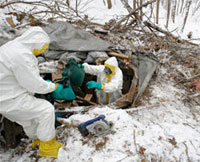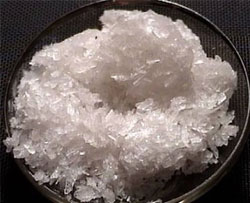Dangers of Meth Labs
 Meth labs are found in remote areas of some of our national forests. As an environmental hazard, the byproducts of meth labs contaminate their surroundings with harmful fumes and highly explosive chemical compounds. Abandoned meth labs are basically time bombs, waiting for the single spark that can ignite the contents of the lab. In the hands of the untrained chemists simultaneously using meth and working with the flammable chemical components, a working meth lab is just as unsafe.
Meth labs are found in remote areas of some of our national forests. As an environmental hazard, the byproducts of meth labs contaminate their surroundings with harmful fumes and highly explosive chemical compounds. Abandoned meth labs are basically time bombs, waiting for the single spark that can ignite the contents of the lab. In the hands of the untrained chemists simultaneously using meth and working with the flammable chemical components, a working meth lab is just as unsafe.
Simply put, meth kills. The drug stimulates the central nervous system, producing excess levels of neurotoxins the brain cannot handle. As a health concern, meth eliminates brain functions and leads to psychosis and, in some cases, deadly strokes. Other long-term effects of meth use include respiratory problems, irregular heartbeat, extreme anorexia, tooth decay and loss, and cardiovascular collapse and death.
How to recognize a Methamphetamine lab?
- Unusual, strong odors like cat urine, ether, ammonia, acetone or other chemicals.
- Coffee filters containing a white pasty substance, a dark red paste, or small amounts of shiny white crystals.
- Glass cookware or stove pans containing a powdery residue.
- Shacks or cabins with windows blacked out.
- Open windows vented with fans during the winter.
- Excessive trash including large amounts of items such as antifreeze containers, lantern fuel cans, engine starting fluid cans, HEET cans, lithium batteries and empty battery packages, wrappers, red chemically stained coffee filters, drain cleaner and duct tape.
- Unusual amounts of clear glass containers.
If you suspect a meth lab, leave at once and report it.
- Do not open any coolers.
- Do not touch any items.
- Handling methamphetamine waste residue can burn your skin and eyes, and breathing in the gases can send you to the hospital.
- Handling these chemicals with unprotected skin, or getting the dust in your eyes can cause serious damage.
 Getting rid of a meth lab is dangerous and expensive. Meth cookers dump battery acid, solvents and other toxic materials into rivers or the ground. Much of the waste is highly flammable and explosive.
Getting rid of a meth lab is dangerous and expensive. Meth cookers dump battery acid, solvents and other toxic materials into rivers or the ground. Much of the waste is highly flammable and explosive.
- One pound of meth produces six pounds of toxic waste.
- Even months after meth labs have been closed, chemical residue still remains.
- The chemicals used in the manufacturing process can be corrosive, explosive, flammable, toxic, and possibly radioactive.
- Solvent chemicals may be dumped into the ground, sewers, or septic systems. This contaminates the surface water, ground water, and wells.
- Traces of chemicals can pervade the walls, drapes, carpets, and furniture of a laboratory site.


